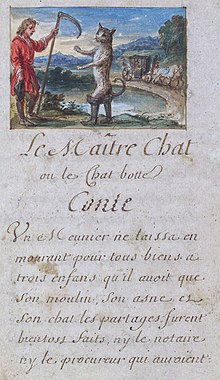Puss in Boots
"Puss in Boots" is a fairy tale. It was written/recorded by Charles Perrault. The story is the classic "animal as helper" tale. It is about a cat who uses tricks and lies to gain power, money, and a princess in marriage for his lowborn master. The story first appeared in a handwritten manuscript in 1695 with four other tales by Perrault. It was published in Paris in 1697 by Claude Barbin in Histoires ou contes du temps passé (English: Stories or Tales of Past Times), a collection of eight fairy tales by Perrault. The book was a great success.
| "Puss in Boots" | |
|---|---|
 Manuscript page | |
| Author | Charles Perrault |
| Translator | Charles Samber (first trans.) |
| Country | France |
| Language | French |
| Characters | Puss in Boots Miller's Son King Princess Ogre |
| Genre(s) | Literary fairy tale |
| Published in | Stories or Tales of Times Past |
| Publication type | Fairy tale collection |
| Publisher | Claude Barbin |
| Media type | |
| Publication date | 1697 |
A tale from Gianfrancesco Straparola's Le piacevoli notti (English: The Pleasant Nights) (1550-55) and another from Giambattista Basile's Pentamerone (1634) are similar to "Puss in Boots". Straparola's story was published in France in 1560. It may have influenced Perrault. Pentamerone was not published in France during Perrault's lifetime. It is not likely he knew Basile's tale.
Story
changeA miller dies. He leaves a cat to his youngest son. The cat requests a pair of boots. He tells the boy he will make his fortune. The cat makes friends with the king by bringing him a wild game in the name of his master. One day, the king rescues the boy from drowning. He dresses him in clothes from his own wardrobe. The king's daughter falls in love with the handsome boy at once. The cat takes possession of a castle for his master by killing an ogre. The boy marries the king's daughter.
References
change- Opie, Iona and Peter. 1974. The Classic Fairy Tales. Oxford UP. pp. 21, 110-12.
- Zipes, Jack (Ed.) 2000. The Oxford Companion to Fairy Tales. Oxford UP. pp. 409.